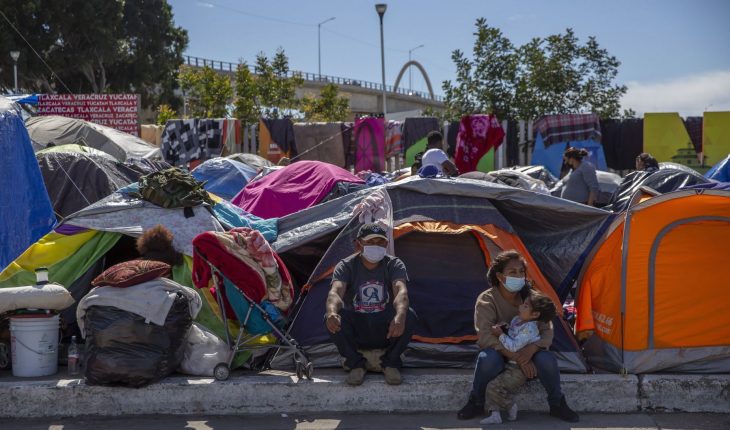Sandra Ocampo Atanasio, 26, is one of the first Mexicans to cross into the United States to seek asylum for more than a year. In February 2020 she arrived with her husband and children in Matamoros, Tamaulipas, fleeing the violence of Guerrero. But the COVID-19 pandemic was crossed and former President Donald Trump closed the borders, suppressing the right to seek refuge. For a year he was living in the camp erected on the banks of the Rio Bravo. Her desperation reached such an extent that she jumped into the nine-month pregnant Rio Bravo in August 2020. But she was arrested, given birth and returned to Mexico with her newborn American in her arms. On March 3, she managed to cross the border by being included within the groups received across the border following Joe Biden’s decision to open the doors to 25,000 asylum seekers who had been expelled by the “Stay in Mexico” program.
You may be interested: He sought asylum and ended the narco: it comes to an end program that put refugees at risk in the Trump era
“We were one of the last to enter. We almost thought they wouldn’t include us, but in the end we got it,” says Ocampo Atanasio in a phone interview from Georgia, where he has settled in a relative’s house. His voice sounds radiant. Everything he dreamed of when he left for the race of Tecpán de Galeana, Guerrero, is being fulfilled for fear of being the next victim of organized crime. She was pregnant with Joshua, her third child, her uncle had been killed and organized crime was already around other members of her family. So she and her husband decided that if Mexico was unable to protect them, they should go and try their luck in another country.
Luck. Or chance. Or be in the right place at the right time. A mixture of all this is what has ultimately allowed Ocampo Atanasio’s family and a handful of mexicans to cross into the United States. For a year they suffered the hardships of the camp: poor hygienic conditions, overcrowding, uncertainty. That’s what allowed them to cross. But they’re an exception and they know it.
Currently no one can seek asylum across the border. Although President Biden has taken measures to make the conditions of migrants and asylum seekers more flexible, Title 42 remains in force, a rule that suspends guarantees at the border and prevents anyone from seeking protection under the excuse of the COVID-19 emergency. According to the U.S. Customs and Border Protection (CBP), more than half a million people have been returned to Mexico since March 2020 under this new regulations. The vast majority of them were Mexicans, such as Ocampo Atanasio.
In fact, Biden’s open door plan was aimed only at those who had their case open within “Stay in Mexico”. This was the program agreed between Trump and Andrés Manuel López Obrador to hinder access to the refuge of Central Americans and that led to the expulsion of more than 70,000 people to dangerous cities like Matamoros. The new U.S. representative finished it as soon as he arrived at the White House and announced that those affected could follow his case into the interior of the country. But this left out Ocampo Athanasius and his family, who arrived at the border and did not have time to seek asylum because the doors were closed by COVID-19.
The Mexicans were able to make the decision to take down the camp. They had been living in that miserable succession of tents for as long as many of their companions. So, at the time of the census, they were included.
Animal Politics consulted with Acnur on the process, but the institution replied that it does not refer to individual cases as part of the protocol for its protection. He did recall that “anyone who suffers violence or persecution has the basic right to seek asylum and must be able to access human, safe and efficient processes.”
That’s what, over the past few years, the United States denied to Central Americans and, also, mexicans.
The Matamoros camp reached 2,500 inhabitants at its peak. Although in its closure it had dwindled. There lived misery and despair with the fear of organized crime, which controls the border. According to the National Institute of Migration (INM), a total of 731 people left the Matamoros camp to cross into the United States following Biden’s announcement that he would receive them. There are no exact figures on how many of them were Mexicans, although Ocampo Atanasio believes there were no more than 15 families. Gone were about 70 people, mostly Central Americans, with the case of asylum closingor on a deportation order in the US. They are currently in the home of the matamoros migrant.
“The entrance was very good.”
“The entrance now was very different, a very nice experience,” says Ocampo Atanasio. This was exactly what she wanted. Enter through the big door, without violating American law, doing everything in accordance with the law and without breaking the laws,” he explains. He recounts that, after coVID-19 testing, they reached the international bridge connecting Matamoros to Brownsville where Sister Norma Pimentel, a religious known for her activism on behalf of migrants, accompanied them. “It was very different, the experience very different because they didn’t behave rude to us,” he says, referencing CPB agents.
His last contact with these officers was traumatic. It happened on August 22 when she, with sheer desperation, crossed Rio Bravo pregnant for nine months. Her husband and children were immediately expelled to Matamoros. She, on the other hand, stayed in the hospital as she arrived with labor pains. They gave her just enough time to give birth to American-born Joshua and be returned to both mother and two-day-old baby in her arms.
That’s all behind us.
“The reception the Americans made to us when we arrived at the bus station was very nice. With applause and hugs they welcomed us,” he explains. “You feel that beautiful emotion. How is it possible that people who don’t even know you receive you so fondly, with such happiness?” he says. Faced with the image of the US cultivated by Trump, that of a hostile and walled place that rejects the one that is different, Ocampo Attanasio values the work of organizations that for two years were supporting the victims of xenophobic policies.
Now that it’s all behind us, the Mexican woman remembers the lessons of the camp. “That’s where we learned to survive,” he says. The change has been big. “Before we slept on a mat, now in a bed. We already cooked on a stove and went to a normal bathroom, not a latrine like the ones in the camp. It’s something very different. This serves as a learning tool to value what life gives us,” he says.
Read more: Mexico only gave work to 64 asylum seekers returned by the US, and not to thousands as promised
Forced displacement in Mexico
His case speaks of a phenomenon that goes unnoticed in Mexico: that of internally displaced persons. Mexicans who are forced to leave everything for fear of being victims of violence and organized crime. Since Felipe Calderón started what he called the “war on drug trafficking”, more than 300,000 dead, more than 84,000 missing and nearly 40,000 un identified bodies have been counted.
In 2020, Mexico became the fourth country with the most asylum formalities in U.S. courts. Of the 59,712 cases that were prosecuted, 6,000,175 were requests for the protection of Mexican citizens, who were only overtaken by Guatemalans, Salvadorans and Hondurans. The results are not hopeful for Ocampo Athanasius and his family. Only 760 were accepted as refugees, while another 208 received some form of additional protection. The rest was rejected and, therefore, a deportation order was turned.
Coming back is something the woman doesn’t even want to think about. “I’m terrified. I’d be afraid that this would happen (to be forced back to Mexico)- In this we come back and come the people who wanted to hurt us. Coming back would be very bad. We were also in Michoacán, there is also very difficult. What do we throw at if we go back? Nothing good,” he says.
The end of the Matamoros camp is just a symbol. Along the border, thousands of people await their opportunity to seek asylum. It’s not just the ones who were expelled for “Stay in Mexico.” Natural disasters, poverty and violence in Central America have led to an increase in flows northward, organizations such as the Mesoamerican Migrant Movement have found. In Mexico more and more people, like Sandra Ocampo Atanasio, believe that no one will be able to protect them in their country and try to cross into the United States.
For the young woman who escaped Guerrero after her uncle’s murder, all of these are fears that are overcoming. Now, as she adjusts to her new life, she thinks about the opportunities her children will have and that she couldn’t even dream of: a good education and safety. Grow up without the fear that someone might hurt you.
What we do at Animal Politics requires professional journalists, teamwork, dialogue with readers and something very important: independence. You can help us keep going. Be part of the team.
Subscribe to Political Animal, receive benefits and support free journalism.#YoSoyAniNot good
translated from Spanish: Guerrero families manage to cross into the US in order to ‘Stay in Mexico’
March 15, 2021 |





